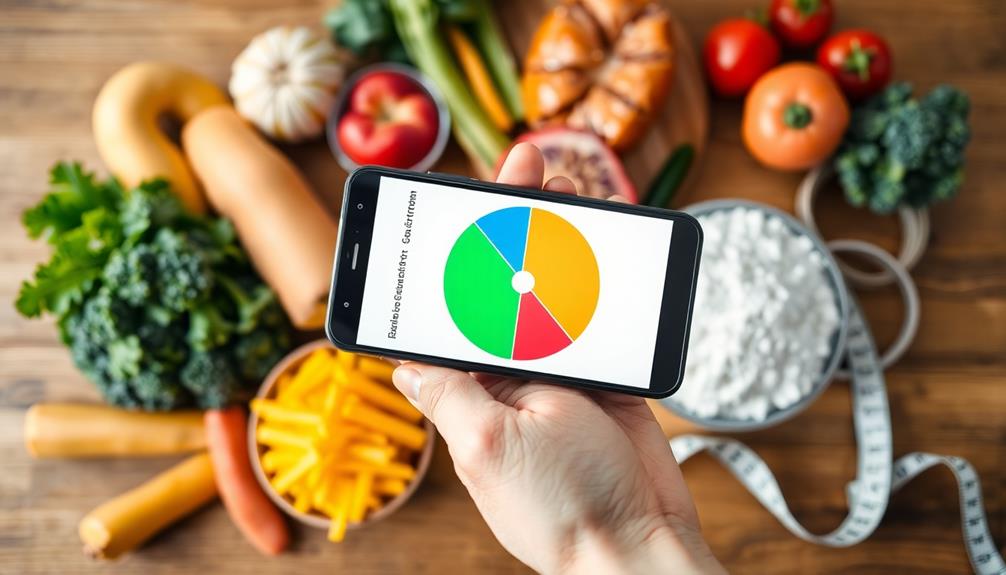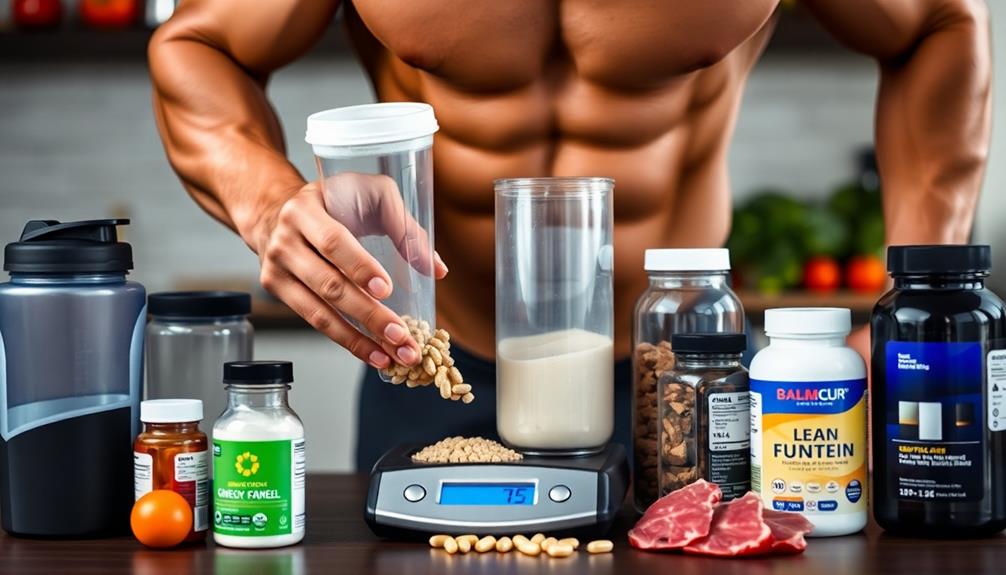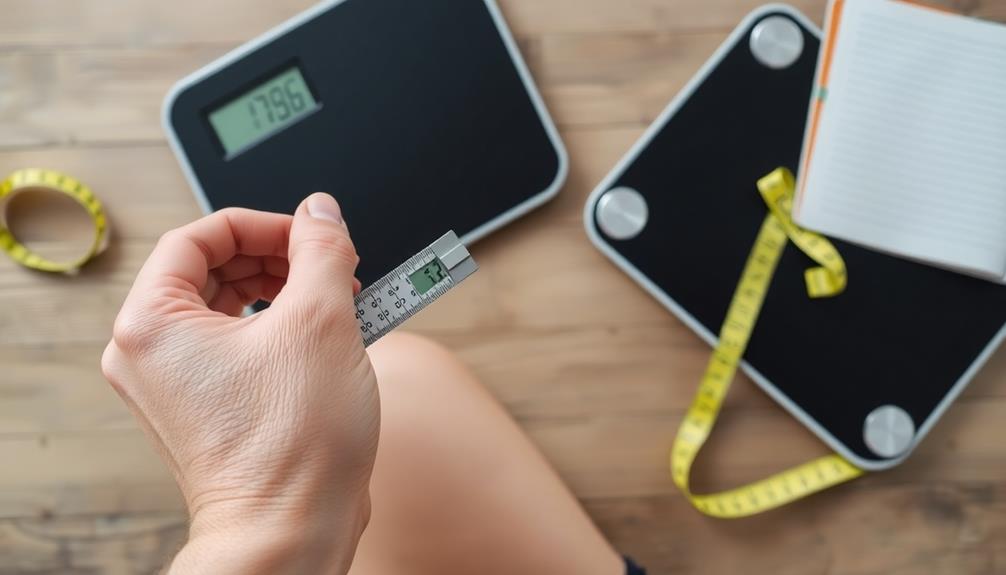To master an extreme cutting diet, you'll need to calculate your macronutrient needs based on your Total Daily Energy Expenditure (TDEE) and apply a 25-30% calorie deficit. Focus on consuming 1.2-1.6 grams of protein per pound of body weight, allocate 20-30% of calories to healthy fats, and fill the rest with complex carbs. Design a meal plan with lean proteins, complex carbs, and plenty of vegetables, spread across 4-6 small meals daily. Incorporate supplements like whey protein, BCAAs, and creatine to support muscle preservation. Maintain strength through heavy weightlifting and include HIIT sessions for fat loss. The following steps will guide you through the process in detail.
Core Insight
- Calculate your TDEE and apply a 25-30% calorie deficit for extreme cutting.
- Consume 1.2-1.6g of protein per pound of body weight to maintain muscle mass.
- Design meals around lean proteins, complex carbs, and vegetables, distributed across 4-6 small meals daily.
- Incorporate supplements like whey protein, BCAAs, and creatine to support muscle preservation and recovery.
- Combine heavy weight lifting with HIIT sessions, prioritizing compound exercises and adequate rest for optimal results.
Understanding Extreme Cutting

Extreme cutting is a short-term diet that aims to help you lose body fat fast while keeping your muscle. You'll eat way fewer calories than usual and exercise a lot. This diet is very strict and not for everyone. Many people use keto supplements to help them stick to the plan and keep their energy up.
When you're extreme cutting, you'll:
- Eat a lot less
- Eat more protein
- Eat fewer carbs
- Do more cardio
- Lift weights to keep your muscle
Keep in mind that extreme cutting is not something you can do for a long time. You'll probably feel tired, hungry, and moody. Bodybuilders and athletes often use this method before a competition or event. Before you try extreme cutting, talk to a doctor or nutritionist to make sure it's safe for you.
Calculating Your Macronutrient Needs

Calculating Your Macronutrient Needs for Extreme Cutting
Figuring out your macros is key to reaching your extreme cutting goals. While tracking macronutrients, remember to include plant-based energy supplements for better workouts and recovery.
Step 1: Find your Total Daily Energy Expenditure (TDEE)
Calculate the calories you burn each day using an online tool or by asking a nutritionist.
Step 2: Choose your calorie deficit
Cut your TDEE by 25-30% for extreme results.
Step 3: Decide on your protein intake
Eat 1.2-1.6 grams of protein per pound of body weight to keep your muscle.
Step 4: Calculate your fat intake
Dedicate 20-30% of your total calories to healthy fats.
Step 5: Use the remaining calories for carbohydrates
Get the rest of your calories from complex carbs to power through workouts and recover well.
Designing Your Meal Plan

Designing your meal plan is easy once you know your macros. Pick lean proteins like chicken, fish, and egg whites as the base of your meals. Then, add complex carbs such as brown rice, sweet potatoes, and oats for energy. Throw in plenty of veggies to fill you up and keep your nutrients balanced. If you're having trouble hitting your numbers, meal replacement powders can help.
Split your daily calories and macros into 4-6 small meals throughout the day. This helps control hunger and keeps your energy up. Don't skimp on healthy fats like avocado or nuts. And make sure to plan your pre- and post-workout meals to fuel your training and recovery. Stick to your meal timing and portions, and you'll crush your extreme cutting goals in no time.
Supplementation for Cutting

Supplements can boost your results when cutting, but they should be used alongside a good meal plan. Here are some key supplements to consider:
| Supplement | Purpose | Recommended Dosage |
|---|---|---|
| Whey Protein | Preserve muscle | 20-30g after workout |
| BCAAs | Help muscles recover | 5-10g during workout |
| Creatine | Maintain strength | 5g per day |
| Multivitamin | Provide nutrients | Follow directions |
| Omega-3s | Promote fat loss, reduce inflammation | 1-3g per day |
Start with these basics and change them as needed. Remember that supplements don't replace a good diet and training plan. They should be used to support your goals. Always talk to your doctor before taking new supplements, especially if you take medications or have health issues. Focus on eating whole foods and use supplements to fill in any gaps.
Training During Extreme Cutting

When you're cutting hard, you need to change up your training to keep muscle while losing fat. Keep lifting heavy to maintain strength, but do less overall volume. Shoot for 3-4 strength workouts per week, focusing on big muscle groups with exercises like squats, deadlifts, and bench presses. Fat burners without stimulants can help support your cutting goals without making you jittery.
Add in high-intensity interval training (HIIT) to burn more fat without breaking down too much muscle. Do 2-3 short, intense HIIT sessions each week. Pay attention to your body and dial back the intensity if you're feeling really tired.
Don't skimp on rest and recovery. Getting enough sleep and taking rest days are key for keeping muscle and feeling good during an extreme cut. Stay on track with your training, but be ready to make changes based on your energy and progress.
Monitoring Progress and Adjusting

Tracking your progress is essential for a successful extreme cut. Each week, record your weight, body measurements, and take progress photos. The scale can be misleading due to water retention, so pay more attention to how you look and how your clothes fit. Natural appetite suppressants may help control cravings and support your weight loss during this intense phase.
Keep a close eye on your energy levels and workout performance. Feeling consistently tired or seeing a decline in your lifts could mean you need to adjust your calorie intake or macronutrient balance. Also, pay attention to your mood and sleep quality, as they can indicate if your diet is sustainable.
Be ready to make adjustments when necessary. If you don't see results after a few weeks, consider slightly reducing your calories or increasing your cardio. On the other hand, if you're losing weight too quickly, you may need to eat a bit more to maintain muscle mass.
Maintaining Results Post-Diet

The switch from a strict diet to a healthy long-term eating plan is key to keeping your results. As you move forward, slowly add more calories each week to avoid gaining weight too fast. Try to increase your intake by 100-200 calories weekly until you reach a level that maintains your weight. Think about using carbohydrate powders after workouts to help your muscles recover and refill energy stores after tough training.
Eat a balanced mix of lean proteins, wholesome carbs, and good fats at each meal. Keep tracking what you eat and your weight to make sure you're staying at your ideal physique. Regular workouts that include both weights and cardio are still important for keeping your muscle and managing body fat.
Be patient as your body gets used to the new eating style. Some changes in weight and body composition are normal at first. Stay steady with your good habits, and don't go back to extreme diets if you see small changes.
Frequently Asked Questions
How Long Should an Extreme Cutting Diet Last?
You shouldn't maintain an extreme cutting diet for more than 4-6 weeks. It's intense and can be risky if prolonged. After this period, shift to a more sustainable diet to maintain your results and protect your health.
Can I Drink Alcohol While on an Extreme Cutting Diet?
You shouldn't drink alcohol on an extreme cutting diet. It's high in empty calories and can hinder fat loss. Alcohol also impairs your judgment, potentially leading to poor food choices. Stick to water and other zero-calorie beverages instead.
What Are Signs That I'm Cutting Too Aggressively?
You're cutting too aggressively if you're constantly tired, irritable, or dizzy. You might experience severe hunger, muscle weakness, and poor workout performance. Watch for rapid weight loss, hair loss, and disrupted sleep patterns. Don't ignore these warning signs.
How Do I Deal With Hunger Pangs During Extreme Cutting?
To deal with hunger pangs during extreme cutting, you can drink water, eat high-volume, low-calorie foods, chew sugar-free gum, and stay busy. Don't skip meals, and consider intermittent fasting to manage hunger better throughout the day.
Is It Safe to Do an Extreme Cut Before a Beach Vacation?
You shouldn't do an extreme cut before a beach vacation. It's risky and can lead to fatigue, weakness, and dehydration. Instead, focus on a balanced diet and moderate exercise for a healthier, more sustainable approach to your goals.

